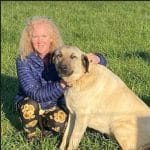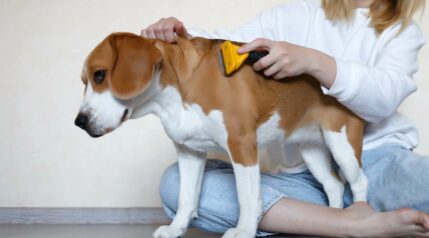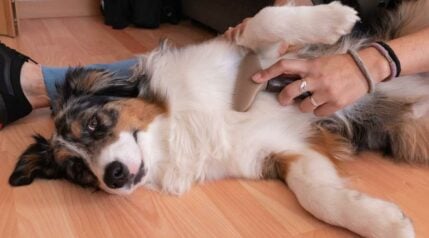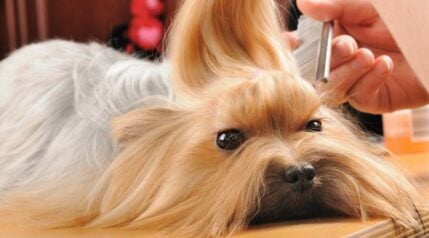If you’re in the market for a Dachshund and concerned about how much they shed, the first thing to consider is that not all Dachshunds shed equally. There are three types of coats in the Dachshund family, both standard and miniature, and each one is different.
A clean fellow without much of a doggy odor, the Doxie has a personality best described as “friendly, curious, and spunky.” If you’ve fallen in love with his winning personality, learn more about each variety to make an informed decision about which best fits your family. Dachshunds are moderate shedders overall but are not considered hypoallergenic.
Within the breed, his coat variety most accurately indicates how much that adorable puppy will shed when he becomes an adult. Whether there’s a member of your household with a dog allergy or you’re trying to make sure you can manage his grooming, consider the traits of each variety. Learn what you’ll need to do to minimize shedding, and your match will be a success.
Dachshund Coats
How much a Dachshund sheds depends largely on his coat. There are three varieties of Dachshund coats: wirehaired, longhaired, and shorthaired versions of the Dachshund, and each type requires a specific type of care and sheds at a different rate.
The wirehaired Dachshund’s coat is uniformly tight, short, and thick. His rough, hard outer coat protects him from the elements and is the reason he sheds the least of the three varieties. Under that rough outer coat is a finer, softer, shorter undercoat everywhere. Maintaining his undercoat helps minimize his shedding. His distinctive beard and eyebrows give him a distinguished, if somewhat grizzled, an air of dignity.
As the name suggests, the longhaired Dachshund has a sleek, elegant coat, longest under
his neck, chest, and body. The hair on his ears and tail is long and silky, and his gracefully carried tail flies happily behind him like a flag. His coat is not so heavy as to hide his muscular shape, and his long hair should never be curly. Most longhaired Doxies have an additional undercoat and shed seasonally.
Shorthaired Dachshunds are called smooth-coated and have a short, sleek coat without an additional undercoat. Often described as wash and wear dogs, smooth Dachshunds’ coats are easy to maintain. Toweling them off and brushing them with a hound mitt periodically knocks off most of the dirt and excess hair. They shed minimally but shed year-round.
Dachshund Colors

Color is a matter of personal preference and does not change how much your pup sheds. Keep in mind you may notice the hairs shed by a black dog on your light beige chair more than you will the hairs shed by a lighter colored dog. Dachshunds may be disqualified for being solid white, but there are many acceptable colors and markings. Standard breed colors include black and cream, black and tan, blue and tan, chocolate and tan, cream, red, wheaten, wild boar, blue and cream, fawn and tan, fawn and cream, and chocolate and cream. Standard markings include brindle, sable, piebald, and dappled.
Dachshund Shedding Frequency
How much and how often a typical Dachshund sheds depends largely on his coat type. If your buddy is a smooth-coated Dachshund, you may hardly notice your dog’s shedding. Their coat is short and sleek, and since they shed year-round, the hairs they leave behind are minimal. If your own pup seems to shed more than you like, you may need to change your grooming routine. Regular brushing and bathing remove hair that would normally be left behind and minimizes what’s deposited in your home.
As you may expect, longhaired Dachshunds will shed more noticeably than their smooth-coated cousins simply because their long hair will be more obvious on clothes and furniture. Although some longhaired Dachshunds have a single coat, most are double-coated dogs. This dense undercoat keeps them warm in cold weather, but they will shed it twice a year. When their undercoat sheds out, they will lose a considerable amount of hair all at once. Brushing out their undercoat can shorten the duration of their shedding season.
The wirehaired Dachshund sheds the least of all types. Their dense undercoat protects them from extremes of weather but does not shed in a typical fashion. They will shed mainly in spring and fall with the change of seasons, and as their undercoat loosens, their rough outer coat will trap it. Less of it will fall on surfaces in the home than with the smooth or longhaired variety. When his undercoat is ready to be removed, your best bet to minimize shedding is to have his coat stripped by a professional groomer.
Hypoallergenic Dogs
During your quest to find a new buddy to add to your family, you may have heard that some breeds are hypoallergenic. If a member of your household may have pet allergies, this sounds particularly desirable. The proteins in your pet’s urine, saliva, or dead skin cells (known as dander), may cause people with pet allergies to have itchy, watery eyes or a stuffy nose. People with more pronounced sensitivities can have symptoms as severe as shortness of breath within fifteen to thirty minutes of inhaling these allergens. Sensitive people may also develop a rash on their face, neck, and upper chest.
If you have a family member who is allergic to pet dander, you want to find a breed with hair that won’t create health problems for your human family or a situation where your pup must be rehomed. Dachshunds do shed and are therefore not considered hypoallergenic, but they shed minimally, and their shedding is manageable. Whether or not this will work in your situation is something you must address frankly before welcoming home your new pup. Remember that any dog, unless it is hairless, is going to have dander and shed.
Other Reasons For Losing Hair

Although shedding itself is a normal process, abnormal shedding can indicate a health problem. Sometimes excessive shedding originates in the skin, also known as the dermis. Inflammation of the skin is called dermatitis (dermis=skin itis=inflammation) and can have a root cause that is either internal or external in origin.
Some breeds of dogs are more prone to specific skin problems than others. If your dog seems to be shedding more than usual and is showing patches of severe hair loss (alopecia), you need to examine the skin beneath the hair. In some cases, dogs may have hormonal or autoimmune disorders that cause dermatitis and hair loss. Aging can exacerbate these conditions. If you notice his skin seems thicker than usual and excessively oily or greasy, has become scaly or red, or has an odor that smells unhealthy, you need to schedule a consultation with your veterinarian. Your dog could suffer from a treatable condition that will respond to vitamin or mineral supplementation or a specific care regimen.
Food sensitivities are tough to diagnose. If you suspect your kibble is the source of your dog’s excessive itching and shedding, you might try a special diet with ingredients formulated not to trigger allergic reactions. Ask your vet what brands and formulas they recommend. You should be able to find a blend that keeps your buddy healthy and happy at a price point you can live with.
Several external causes of hair loss strike all dogs, regardless of breed. Dogs can be allergic to flea bites. Other parasitic causes of hair loss include sarcoptic or demodectic mange. Both fungal and bacterial infections of the skin can cause excessive shedding. If you know you have a flea problem, putting together an effective flea management regimen is the first line of defense, but if your buddy is still itchy after the fleas are gone, a visit with your vet is in order. They may perform a “skin scrape” and examine the sample under a microscope to decide the proper course of treatment.
Managing Dachshund’s Shedding
Dachshunds in general and wirehaired Dachshunds, in particular, are a low-shedding breed, but they still need to be groomed according to their coat types. Here are the best ways to manage their coat and reduce shedding in smooth-coated, longhaired, and wirehaired varieties.
Types Of Brushes
How much you need to brush your Dachshund and what type of brush you’ll need to do it depends on your buddy’s coat type. Choose your grooming tools with care. With a bristle brush, the wirehaired Dachshund’s coat will bloom with daily attention. The long, silky coat of the longhaired Doxie requires a slicker brush to detangle it and then a bristle brush to smooth it to a shine. For Mr. Smooth, a hound mitt or grooming glove brings his coat to a mirror shine.

Best For Wirehaired Dachshunds
Fine-toothed Comb

Best For Longhaired Dachshunds
Slicker Brush

Best For Smooth Dachshunds
Grooming Glove
Note: Clicking the above links take you to Amazon.com, where you can get additional product information and customer reviews. If you make a purchase, we earn a commission at no additional cost to you.
If you have a wirehaired pup, the hair he sheds falls back into his coat. Brushing it removes it, making it less likely to end up on you or your furniture. Regular brushing stimulates blood circulation and distributes oils throughout his hair so that even his rough coat has the glow of health. When seasons change, wirehaired Doxies will shed their undercoat and will benefit from professional grooming. At home, combing your wirehaired Dachshund daily with a fine-toothed flea comb will help remove any hairs trapped in his coat.
The longhaired Dachshund’s coat may need more attention, especially if he spends much time outdoors. You’ll need to brush him almost every day to remove any dirt and debris he picks up outside. A slicker brush will help you remove dirt and mats from their coat, and you can follow up with a bristle brush to make their coat shine. Their ears and feet are the areas that are most likely to get matted, so check them thoroughly before they become knotted beyond repair.
The smooth Dachshund has the easiest coat to maintain of the three varieties. His sleek coat could go days between brushings, but to minimize shed hairs (his coat sheds constantly), give him a once-over daily with a hound mitt or grooming glove. He’ll feel like you’re petting him, but you’ll actually improve the health of his skin by stimulating the production of natural oils and distributing them through his haircoat. His coat will gleam with health.
Shampoo
Always choose a dog-safe shampoo. If your pup’s skin is on the sensitive side, choose a shampoo specifically formulated for sensitive skin. Even with a gentle shampoo, shampooing him too frequently can strip the natural oils from his coat and dry his skin, so limit baths to once every few months. It’s easiest to get all the loose fur out of your Dachshund’s coat while he’s still wet or damp.
Diet
Your Dachshund’s coat directly reflects his health, and health begins with good nutrition. Feeding dog food that does not contain known allergens is the first building block of coat health. Many dogs are allergic to chicken in commercial dog foods. If you’re worried your pup may have a food sensitivity, try a chicken-free formula.
Nutritional deficiencies from lower-quality dog foods can also cause dermatitis and excessive shedding. Finding a quality food with ingredients your particular dog can tolerate may take a bit of leg work up front, but in the long run, it will save you money in additional supplements and vet bills. More importantly, it will save your best friend unnecessary discomfort and optimize his health.
The brand you choose should include omega-3 fatty acids. Omega-3 fatty acids have anti-inflammatory properties considered beneficial for dogs’ skin and coats. Research has shown that omega-3s have health benefits for dogs beyond making their coats shine. They reduce inflammation in the body, keeping your buddy more comfortable and keeping itchy skin at bay.
Supplements
Omega-3 supplements and treats are an easy way to add more omega fats into your Doxie’s diet. Fish oils add omega-3s to promote a healthy coat and reduce shedding. Some supplements contain a blend of fish and plant-based oils to provide a balanced ratio of the three main types of omega-3 fatty acids, alpha-linolenic acid (ALA), eicosapentaenoic acid (EPA), and docosahexaenoic acid (DHA).
Frequently Asked Questions
Do Dachshunds Shed A Lot?
Compared to other breeds of dogs, Dachshunds are moderate to minimal shedders. Longhaired Dachshunds shed the most noticeably, although they are seasonal shedders. Smooth-coated Doxies shed constantly, but not very much. The wirehaired Dachshund sheds least of all.
Do I Need To Take My Dachshund To A Groomer?
You probably won’t need to take your Dachshund to a groomer unless your wirehaired Doxie is shedding his undercoat. Having his coat professionally stripped will shorten his shedding season.
When Is It Time To Take My Dachshund To The Vet?
If your dog is shedding more than normal, inspect the skin beneath his coat. If you notice that his skin seems thick, greasy, scaly, red, or foul-smelling, schedule a consultation with your veterinarian.
Final Thoughts
If you fall in love with a Dachshund, it is probably for his spunky, fun-loving personality. If minimal shedding is part of your criteria for your new Doxie best friend, you’ll want to meet the dignified wirehaired Dachshund. He sheds least of all the varieties. Remember that even though they shed less than other dogs, Dachshunds are not hypoallergenic dogs. Care for your wirehaired Dachshund’s coat with the proper tools and the occasional mild shampoo. Feed him a quality diet with omega-3 fatty acids to reduce inflammation and keep his skin healthy from the inside out. Your Doxie may still leave hairs on your furniture, but with proper management, all you’ll notice are the pawprints he leaves on your heart.





